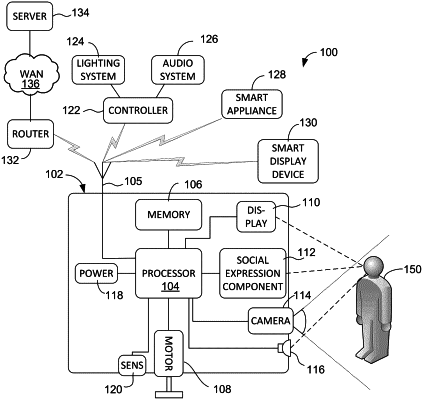| CPC B25J 11/0005 (2013.01) [B25J 13/003 (2013.01); G06N 3/008 (2013.01)] | 21 Claims |

|
1. A social robot, comprising:
one or more processors coupled to at least one circuit for driving components of the social robot;
a social expression component connected to the at least one circuit, the social expression component comprising a human-recognizable expressive feature controlled by the one or more processors according to a social behavior algorithm, wherein the human-recognizable expressive feature comprises at least one of a display screen configured for displaying facial expressions or a mechanism for moving a head of the social robot;
at least one of a camera connected to the at least once one circuit, positioned for observing a user interacting with the social robot or a microphone connected to the at least one circuit, positioned for receiving sound from the user; and
a program memory, coupled to the at least one circuit and to the one or more processors, the program memory holding program instructions configured for execution by the one or more processors, causing the social robot to perform operations comprising:
interacting socially with the user by the social expression component;
determining user behavior based at least in part on data from the at least one of the camera or the microphone;
correlating the user behavior to social behavior of the social robot;
generating an electronic control signal based on the correlating, the generating comprising determining a current mental state indicator based on the correlating, comparing metadata for prospective responses to a representation of the mental state indicator, identifying one of the prospective responses at least in part by the representation, and configuring the electronic control signal to indicate the identified the prospective responses; and
transmitting the control signal configured for causing an electronic output device to respond to information encoded by the control signal.
|